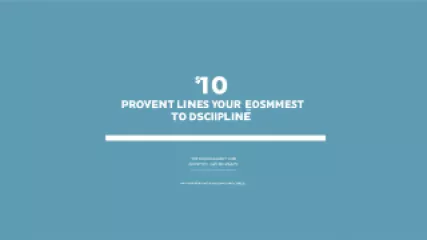10 Proven Strategies to Boost Your Self-Discipline
10 Proven Strategies to Boost Your Self-Discipline
Self-discipline is a crucial skill that can unlock a world of opportunities and success in both our personal and professional lives. Whether it's sticking to a fitness regimen, staying on top of work deadlines, or cultivating healthy habits, the ability to exercise self-control and stay focused on our goals is paramount. However, building and maintaining self-discipline can be a challenging and ongoing journey for many of us.
In this comprehensive list, we'll explore 10 proven strategies that can help you boost your self-discipline and achieve your aspirations. From developing a strong mindset to incorporating practical habits, these techniques have been implemented by successful individuals across various fields. By incorporating these strategies into your daily life, you'll be well on your way to becoming a more disciplined, focused, and accomplished person.
1. Establish a Clear Vision and Set Specific Goals
The foundation of self-discipline lies in having a clear vision of what you want to achieve and setting specific, measurable goals to guide your efforts. Take the time to reflect on your values, dreams, and long-term aspirations. What do you hope to accomplish in your personal, professional, or physical well-being? Once you have a solid understanding of your desired outcomes, break them down into smaller, actionable steps that you can tackle one by one.
Setting SMART (Specific, Measurable, Achievable, Relevant, and Time-bound) goals is a proven strategy for cultivating self-discipline. By having a clear roadmap and specific targets to reach, you'll be more motivated to overcome obstacles and persist in the face of challenges. Regularly reviewing and adjusting your goals as needed can also help you stay on track and maintain your momentum.
2. Develop a Positive Mindset
Your mindset plays a crucial role in your ability to exercise self-discipline. Cultivating a positive, growth-oriented mindset can significantly enhance your chances of success. Instead of focusing on the difficulties or potential roadblocks, adopt a mindset of resilience and a willingness to learn from setbacks.
Practice self-compassion when you fall short of your goals. Acknowledge your efforts and celebrate small wins along the way, rather than berating yourself for perceived failures. Surround yourself with positive influences, whether it's motivational content, supportive friends, or mentors who embody the kind of self-discipline you aspire to. By nourishing a mindset of optimism, perseverance, and self-belief, you'll be better equipped to overcome temptations and stay committed to your objectives.
3. Eliminate Distractions and Simplify Your Environment
In today's fast-paced, technology-driven world, distractions are abundant and can easily derail our efforts to maintain self-discipline. To counteract this, it's essential to create an environment that supports your goals and minimizes potential disruptions.
Begin by identifying and minimizing the sources of distraction in your life. This might involve limiting your social media usage, silencing notifications on your devices, or designating specific times for checking email. Additionally, consider decluttering your physical space and creating a dedicated workspace that is free from visual clutter and external stimuli. A clean, organized environment can have a profound impact on your ability to stay focused and productive.
4. Develop Routines and Habits
Consistency is key when it comes to building self-discipline. By establishing routines and habits, you can leverage the power of repetition to turn disciplined behaviors into automatic responses. Start by identifying the areas of your life where you'd like to increase self-discipline, such as exercise, healthy eating, or time management.
Develop a daily or weekly routine that incorporates these desired behaviors, and strive to stick to it diligently. Use tools like calendars, alarms, or habit-tracking apps to help you stay on track. Over time, these routines will become ingrained, requiring less willpower and mental effort to maintain. Embracing habit formation can be a powerful way to transcend the ups and downs of motivation and ensure that your disciplined actions become second nature.
5. Practice Delayed Gratification
One of the hallmarks of self-discipline is the ability to delay immediate gratification in pursuit of long-term goals. This can be challenging, as our brains are wired to seek out pleasure and rewards in the present moment. However, by cultivating the skill of delayed gratification, you can train your mind to prioritize your long-term well-being over short-term impulses.
Start by identifying situations where you might be tempted to indulge in instant gratification, such as snacking on unhealthy foods or binge-watching television. When faced with these temptations, pause, take a deep breath, and consciously choose to delay the immediate reward in favor of your bigger goals. Over time, this practice will strengthen your self-control and help you develop the mental fortitude to stay the course, even when it's difficult.
6. Break Tasks into Smaller, Manageable Steps
Tackling large, complex tasks can be daunting and overwhelming, which can undermine your self-discipline. To counteract this, break down your goals and projects into smaller, more manageable steps. This not only makes the tasks feel less intimidating but also provides a sense of progress and accomplishment as you check off each step.
For example, if your goal is to write a book, don't think of it as a single, monumental task. Instead, break it down into smaller steps, such as conducting research, outlining the chapters, writing a certain number of words per day, and editing the manuscript. By focusing on these bite-sized tasks, you'll be more likely to maintain your momentum and stay motivated throughout the process.
7. Embrace Accountability
Accountability is a powerful tool for boosting self-discipline. When we know that we're answerable to someone else for our actions (or inactions), it can provide an extra layer of motivation and incentive to follow through on our commitments.
Consider finding an accountability partner, such as a friend, family member, or mentor, who can regularly check in on your progress and hold you accountable to your goals. Alternatively, you can join a supportive online community or seek the guidance of a self-discipline coach who can provide personalized support and accountability measures. Regularly reporting your progress and setbacks to your accountability partner or coach can help you stay focused and motivated, even when the going gets tough.
8. Practice Self-Care and Manage Stress
Maintaining self-discipline requires a delicate balance between pushing yourself and taking care of your overall well-being. If you're constantly feeling overwhelmed, stressed, or depleted, it can become increasingly difficult to muster the energy and focus needed to uphold your disciplined habits.
Make it a priority to incorporate self-care practices into your routine, such as getting enough sleep, engaging in regular exercise, and finding time for relaxation and leisure activities. By tending to your physical, mental, and emotional needs, you'll be better equipped to navigate the challenges of self-discipline with resilience and clarity of mind.
9. Celebrate Small Wins and Reward Yourself
While the pursuit of long-term goals is essential, it's important to recognize and celebrate your progress along the way. Acknowledging your small wins and rewarding yourself for your efforts can provide a much-needed boost of motivation and reinforcement.
As you achieve your mini-milestones, take a moment to reflect on your accomplishments and treat yourself to something enjoyable, whether it's a favorite snack, a relaxing activity, or a small indulgence. These rewards don't have to be grand; the key is to associate your disciplined actions with positive reinforcement, which can help solidify the habits you're cultivating.
10. Continuously Evaluate and Adjust
Self-discipline is not a static state; it's a dynamic process that requires ongoing evaluation and adaptation. As you implement these strategies and work towards your goals, be mindful of what's working well and what areas may need adjustments.
Regularly review your progress, reflect on your successes and setbacks, and be willing to tweak your approach as needed. This might involve revising your goals, experimenting with different habits or routines, or seeking additional support or resources. By remaining flexible and open to continuous improvement, you'll be better equipped to overcome obstacles and sustain your self-discipline in the long run.
Mastering self-discipline is a journey, not a destination. By incorporating these 10 proven strategies into your life, you'll be well on your way to becoming a more disciplined, focused, and accomplished individual. Remember, self-discipline is a skill that can be developed and refined over time, so be patient with yourself and celebrate the progress you make along the way. Embrace the challenges, learn from your experiences, and watch as your self-discipline transforms into a powerful tool for achieving your dreams.






